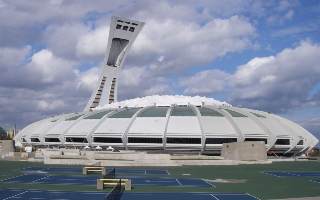Montreal Olympic Stadium
| Capacity | 55 000 |
|---|---|
| Country | Canada |
| City | Montreal |
| Clubs | – |
| Category | Design being implemented |
| Cost | C$729.3 M ($530 M) |
| Construction | 2024–2027 |
| Design | sbp, gmp Architekten |
| Contractor | Groupe Construction Pomerleau-Canam |
Advertisement
Montreal Olympic Stadium – design description
In short: what does the renovation of Montreal’s Olympic Stadium involve?
The renovation of Montreal’s Olympic Stadium focuses on replacing one key element – the central portion of its roof. While this may sound simple, the process is in fact complex and extremely costly. It is expected to take four years, during which the stadium will remain closed to the public.
The central part of the roof has caused numerous problems over the years. It was originally intended to be retractable, but the ambitious design proved faulty and, in 1998, was replaced with a fixed structure that could no longer open or close. That replacement, however, was also poorly executed and required replacement almost from the start.
Due to a prolonged decision-making process, the roof replacement didn’t begin until a quarter of a century had passed. This time, however, the new structure is expected to be fault-free and last for another 50 years. Construction began in spring 2024 and is scheduled to be completed by 2027, with the stadium reopening planned for 2028.
This iconic venue – a symbol of Montreal and a legacy of the 1976 Olympic Games – will be preserved for future generations, and its full potential is finally expected to be realized.
Separate from the roof replacement, work is also being carried out on the iconic tower integrated with the stadium. This renovation began in 2021 and is scheduled to be completed by 2027.
What does the Montreal Olympic Stadium look like?
The Montreal Olympic Stadium was built for the 1976 Summer Olympics, for which it served as the main venue. Although the Games were originally planned to be modest and cost-effective, the stadium was designed on a grand scale, featuring a highly futuristic and ahead-of-its-time design. The bold concept was created by French architect Roger Taillibert.
The stadium is considered a masterpiece of organic architecture and remains one of Montreal’s most recognizable landmarks. An integral part of the structure is the iconic 165-meter-tall tower with an observation deck accessible by funicular. Inclined at a 45-degree angle, the tower supports the roof and is the tallest inclined tower in the world.
The stadium can accommodate over 56,000 spectators, making it one of the largest in Canada. The original design included a retractable roof, but this proved to be faulty and was replaced by a fixed roof that cannot be opened.
The innovative building came at a high cost – it was not fully paid off until late 2006, more than 30 years after its opening. Including repairs, interest, and inflation, the final costs exceeded 1.6 billion Canadian dollars, making it one of the most expensive stadiums in the world.
The stadium is owned by the government of Quebec and managed on its behalf by the Société de développement et de mise en valeur du Parc olympique, known as Régie des installations olympiques (RIO) until 2020.
Why does the Montreal Olympic Stadium’s roof need renovation?
From the start, the stadium faced significant problems. Besides construction costs soaring to more than ten times the original budget, the project was not completed on time – the tower and the central retractable section of the roof were not ready for the Games.
The tower was only completed in 1987, over a decade after the stadium’s inauguration. That’s when the retractable roof system was finally installed.
The innovative roof-closing system relied on 26 cables anchored on one side to the tower and on the other to a ring atop the fixed concrete roof structure. A Kevlar membrane was stretched over these cables, closing the space above the playing field.
What problems did the roof of the Montreal Olympic Stadium cause?
Just one year after the installation of the Kevlar retractable membrane, a storm tore it in two. Soon after, human error caused another tear. Further significant damage occurred in 1991. In 1993, the retractable function was abandoned and the roof was permanently fixed in the closed position.
When was the first permanent roof installed on Montreal’s Olympic Stadium?
The problematic retractable roof was eventually abandoned. In 1996, a tender was announced for the construction of a permanent roof to replace it. In 1997, the contract was awarded to Birdair, and the installation of the fixed roof took place in 1998.
The oval opening in the central part of the roof was filled with a metal structure, topped with a white fiberglass membrane coated with Teflon.
However, the new roof also turned out to be defective. Early in 1999, part of the roof collapsed under heavy snow, causing minor injuries to several workers preparing for an auto show.
The event was cancelled, and since then the stadium remained closed during winter months. Events were also cancelled whenever snowfall forecasts exceeded 3 cm.
This severely limited the venue’s operational capabilities. The stadium also lost its two main tenants, the Montreal Expos (MLB) and the Montreal Alouettes (CFL).
Inspections carried out in the following years revealed increasing damage to the roof. Nevertheless, the stadium remained in use – in 2015, it was even one of the venues for the FIFA Women’s World Cup.
Was there ever a risk of the Montreal Olympic Stadium being demolished?
Years of ongoing problems with the roof and stadium operations sparked calls for demolition, which many considered a rational economic solution, especially given the high costs of replacing the central roof section.
Opponents of demolition argued that the stadium is an iconic legacy of the Montreal Olympics and a tourist attraction. The building adds prestige to the city and, with proper investment, can still thrive and generate significantly more revenue.
Additionally, demolishing the stadium could be complicated by the adjacent metro tunnel and other factors that make controlled demolition difficult.
How did the second roof replacement at Montreal’s Olympic Stadium come about?
When were the first steps taken toward the next roof replacement at Montreal’s Olympic Stadium?
Since the new structure failed to meet expectations, in 2002 the Régie des installations olympiques began searching for a company to build a new, third roof (specifically, its central section that closes off the whole structure).
In 2008, a proposal by SNC-Lavalin was approved, offering a new solution to the problem.
How was the new roof design for Montreal’s Olympic Stadium developed?
Since SNC-Lavalin’s proposal was the only one meeting the requirements, the process restarted in 2010 with an analysis of various options, including the possible return to a retractable roof, which was ultimately rejected.
By 2017, a Dossier d’opportunité was prepared, serving as a preliminary feasibility study. At that time, the estimated cost for replacing the central roof section was between CAD 200 and 250 million.
In April 2018, collaboration began with the engineering consultancy WSP, and in August 2018 the German firm schlaich bergermann partner (sbp) was engaged to work on the new roof design, undertaking the project together with von Gerkan, Marg and Partners (gmp Architekten).
In October 2019, the search for a contractor to execute the new roof began. In June 2020, it was announced that the only qualified candidate was the consortium Groupe Pomerleau and Canam (Groupe Construction Pomerleau-Canam, GCPC).
Architectural firms gmp and sbp were then joined by ACDF, Lemay, and Walter P. Moore, who together developed the new roof project. In July 2023, it was announced that the project would also require replacement of a part of the fixed concrete roof structure — specifically, the oval technical ring at the top.
The prolonged decision-making process meant that the defective structure, originally intended to be replaced shortly after installation, ultimately lasted through the planned 25-year service life.
When was the contract signed for the new roof at Montreal’s Olympic Stadium?
After years of waiting, on February 5, 2024, the Quebec authorities announced the start of the new roof replacement project. They also revealed more details about the investment, stating readiness to invest CAD 870 million in the roof replacement.
On February 23, 2024, the contract was signed with Groupe Construction Pomerleau-Canam, valued at CAD 729.3 million, slightly less than the initially announced amount. The agreement covers not only construction but also periodic inspections and repairs of the roof over the next 10 years.
What does the Olympic Stadium’s renovation project in Montreal involve?
The project focuses on replacing the central section of the roof, which for many years caused numerous problems and prevented the stadium from functioning properly.
The current structure, completed in 1998, will be replaced with a new one that, like its predecessor, will be permanent (without the retractable function included in the original concept). The new installation is designed to avoid the flaws of the previous designs and is expected to last 50 years.
The project also includes the replacement of the technical compression ring that connects the reinforced concrete structure of the roof at its top. The existing ring, elliptical in shape and 468 metres long, was made of reinforced concrete, placing considerable load on the structure – the new ring will retain a similar form but will be made of steel, reducing its weight by a factor of about six.
The large oval opening in the roof will be filled with a new flat structure covering the space above the field. This new structure will consist of two main sections: a central elliptical truss covered with a white, opaque membrane, and a surrounding glazed ring that will allow sunlight to enter the stadium interior.
The surface area of the new structure will total 17,000 m², including 10,000 m² for the opaque central section and 7,000 m² for the glazed perimeter.
The new central roof section will be suspended on 24 load-bearing cables anchored to the tower above the stadium. These cables will carry 75% of the structural load, with the remaining 25% supported by the stadium’s reinforced concrete frame.
As part of the renovation, the lighting, sound, and ventilation systems will also be replaced.
What changes will be made to the Montreal Tower during the roof renovation?
Alongside the replacement of the roof’s central section, another investment is underway at the stadium involving the renovation of the iconic tower, an integral part of the complex.
This project is focused primarily on tourism and includes the refurbishment of the Welcome Hall, replacement of the funicular taking visitors to the top, and construction of a new glazed observatory on the roof of the tower.
Work on the tower began in summer 2021, ahead of the roof replacement. Initially planned for completion in 2023 or 2024, the schedule was later pushed back to 2026 (coinciding with the stadium’s 50th anniversary), and subsequently to 2027. The cost of the tower renovation increased from the originally planned C$55 million to over C$122 million.
What will the modernization of the Olympic Stadium in Montreal achieve?
Thanks to the replacement of the central roof section, the stadium will gain a fault-free, fully covered roof, enabling it to realize its full potential and become one of Canada’s leading sports venues, capable of hosting high-profile events.
Restoring full operational capacity and enabling year-round use, including in winter, is expected to raise the number of events from 30 to 150 per year, double the number of visitors from 1 million to 2.1 million, and significantly increase revenue.
The modernization will preserve the iconic, flagship stadium for decades to come. It has become one of Montreal’s landmarks and tourist attractions, a legacy of the 1976 Olympic Games, and an outstanding example of modernist organic architecture.
When will the modernization of Montreal’s Olympic Stadium take place?
The replacement of the stadium’s central roof section is expected to take four years, during which the venue will be closed. Work began in spring 2024 and is scheduled for completion in 2027, with reopening planned for 2028.
The project has been divided into three main phases:
- Dismantling of the existing structure in the central roof section – completed by the end of 2024
- Replacement of the oval technical ring crowning the reinforced concrete structure – scheduled for 2025
- Installation of the new central roof section – scheduled for 2026–2027
The renovation requires protection of exposed elements vulnerable to harsh weather conditions during the period when the stadium will be without full roof coverage. Materials from the dismantled structure are to be recycled, and a competition was even held to select the best ideas for their reuse.
The separately managed renovation of the tower began in 2021 and is expected to be completed in 2027.
A report on the renovation works at Montreal's Olympic Stadium can be seen on a separate page
Advertisement
Renderings
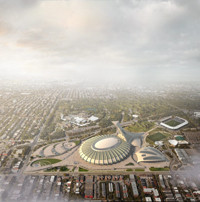
2024 © gmp Architekten 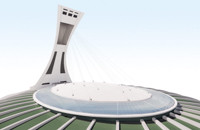
2024 © gmp Architekten 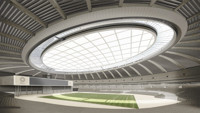
2024 © gmp Architekten 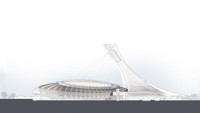
2024 © gmp Architekten
Related news
2025
-
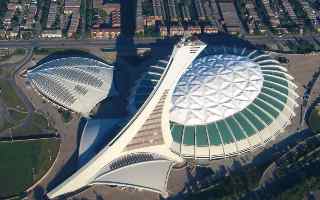
Canada: New roof for Montreal’s Olympic Stadium is getting closer
Significant modernization work is progressing steadily at Montreal’s Olympic Stadium, a landmark venue that has long been in need of a major overhaul. The project has reached a critical stage involving the dismantling of the stadium’s technical ring — a large concrete structure that surrounds the opening in the roof.
-
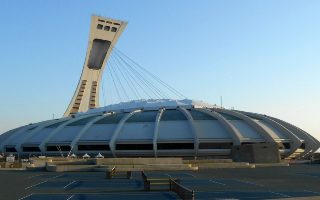
Canada: Olympic Stadium in Montreal on track for major revitalization by 2028
Montreal’s iconic Olympic Stadium has been undergoing significant renovations in recent years, and a new large-scale project is currently underway to replace its aging roof. This ambitious undertaking is particularly complex due to the massive size of the stadium and the unique architectural features of the original structure.
-
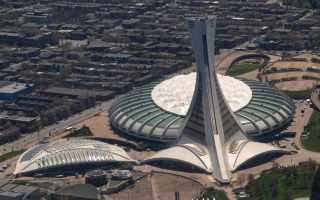
Canada: Longer and more expensive renovation of Montreal Olympic Stadium tower
The renovation of the iconic inclined tower of the Olympic Stadium in Montreal—one of Canada’s most recognizable architectural landmarks—is set to take longer than initially planned.

 StadiumDB
StadiumDB